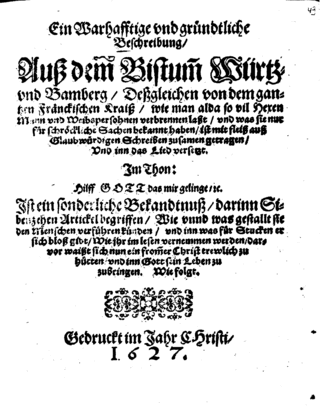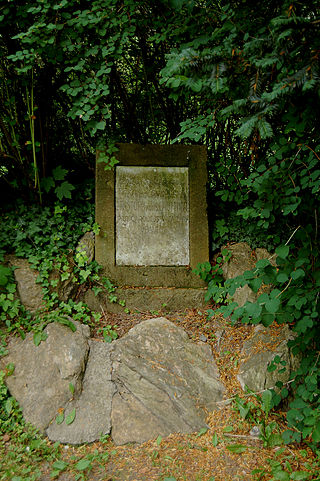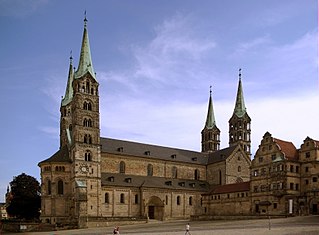
A witch-hunt, or a witch purge, is a search for people who have been labeled witches or a search for evidence of witchcraft. The classical period of witch-hunts in Early Modern Europe and Colonial America took place in the Early Modern period or about 1450 to 1750, spanning the upheavals of the Reformation and the Thirty Years' War, resulting in an estimated 35,000 to 50,000 executions. The last executions of people convicted as witches in Europe took place in the 18th century. In other regions, like Africa and Asia, contemporary witch-hunts have been reported from sub-Saharan Africa and Papua New Guinea, and official legislation against witchcraft is still found in Saudi Arabia and Cameroon today.

The Salem witch trials were a series of hearings and prosecutions of people accused of witchcraft in colonial Massachusetts between February 1692 and May 1693. More than 200 people were accused. Thirty people were found guilty, 19 of whom were executed by hanging. One other man, Giles Corey, was pressed to death after refusing to enter a plea, and at least five people died in jail.

The Würzburg witch trials of 1625–1631, which took place in the self-governing Catholic Prince-Bishopric of Würzburg in the Holy Roman Empire in present-day Germany, formed one of the biggest mass trials and mass executions ever seen in Europe, and one of the largest witch trials in history.

The Basque Witch Trials of the seventeenth century represent the last attempt at rooting out supposed witchcraft from Navarre by the Spanish Inquisition, after a series of episodes erupted during the sixteenth century following the end of military operations in the conquest of Iberian Navarre, until 1524.

Werewolf witch trials were witch trials combined with werewolf trials. Belief in werewolves developed parallel to the belief in European witches, in the course of the Late Middle Ages and the Early Modern period. Like the witchcraft trials as a whole, the trial of supposed werewolves emerged in what is now Switzerland during the Valais witch trials in the early 15th century and spread throughout Europe in the 16th, peaking in the 17th and subsiding by the 18th century. The persecution of werewolves and the associated folklore is an integral part of the "witch-hunt" phenomenon, albeit a marginal one, accusations of lycanthropy involved in only a small fraction of witchcraft trials.
The Pappenheimer Case centered around a family who were tried and executed for witchcraft in 1600 in Munich, Bavaria, Germany. The family were executed, along with accomplices they were forced to name under torture, after a show trial as scapegoats for a number of unsolved crimes committed years back in a display of extreme torture intended to deter the public from crime. The witch trial resulted in the death of twelve people: four of the Pappenheimer family and two of their accused accomplices in the first trial, followed by the remaining member of the family and five other accomplices in the second trial. The trial was of one of the most well-publicized witch trials in German history.
In the historical folklore of Sicily, Doñas de fuera were supernatural female beings comparable to the fairies of English folklore. In the 16th to mid-17th centuries, the doñas de fuera also played a role in the witch trials in Sicily.

Northern Moravia witch trials, also known as Boblig witch trials was a series of witch trials which occurred in the Jeseník and Šumperk area in the present-day Czech Republic, between 1622 and 1696. They are among the largest and most well known Czech witch trials.

The Bamberg witch trials of 1627–1632, which took place in the self governing Catholic Prince-Bishopric of Bamberg in the Holy Roman Empire in present-day Germany, is one of the biggest mass trials and mass executions ever seen in Europe, and one of the biggest witch trials in history.
The Great Scottish Witch Hunt of 1597 was a series of nationwide witch trials that took place in the whole of Scotland from March to October 1597. At least 400 people were put on trial for witchcraft and various forms of diabolism during the witch hunt. The exact number of those executed is unknown, but is believed to be about 200. The Great Scottish Witch Hunt of 1597 was the second of five nationwide witch hunts in Scottish history, the others being The Great Scottish Witch Hunt of 1590–91, The Great Scottish Witch Hunt of 1628–1631, The Great Scottish witch hunt of 1649–50 and The Great Scottish Witch Hunt of 1661–62.
The Lisbon witch trial took place in 1559-1560 and resulted in the execution of six women for witchcraft. The trial in Lisbon resulted in a general inquiry of witchcraft in Portugal, which resulted in 27 additional people being accused, and one more receiving a death sentence the following year. This was arguably the only witch trial with multiple death sentences that ever took place in Portugal.

The Eichstätt witch trials was a series of witch trials that took place in the Prince-Bishopric of Eichstätt, Bavaria, Germany, between 1532 and 1723. They resulted in the execution of at least 224 people, and were among the biggest witch trials in Germany. The trials were mainly conducted under the approval of Prince Bishop Johann Christoph von Westerstetten between 1613 and 1630. The last known execution in Eichstätt was conducted in 1723.

Sweden was a country with few witch trials compared to other countries in Europe. In Sweden, about four hundred people were executed for witchcraft prior to the last case in 1704. Most of these cases occurred during a short but intense period; the eight years between 1668 and 1676, when the witch hysteria called Det stora oväsendet took place, causing a large number of witch trials in the country. It is this infamous period of intensive witch hunt that is most well known and explored and given attention.

The witch trials in the Holy Roman Empire, composed of the areas of present-day Germany, Switzerland and Austria, were the most extensive in Europe and in the world, both to the extent of the witch trials as such as well as to the number of executions.
Witch trials in Latvia and Estonia were mainly conducted by the Baltic German elite of clergy, nobility and burghers against the indigenous peasantry in order to persecute Paganism by use of Christian demonology and witchcraft ideology. In this aspect, they are similar to the Witch trials in Iceland. They are badly documented, as many would have been conducted by the private estate courts of the landlords, which did not preserve any court protocols.
The witch trials in the Netherlands were among the smallest in Europe. The Netherlands are known for having discontinued their witchcraft executions earlier than any other country in Europe. The provinces began to phase out capital punishment for witchcraft beginning in 1593. The last trial in the Northern Netherlands took place in 1608 and the last trial on the territory of the modern-day Netherlands was in 1613.
The witch trials in Poland started later than in most of Europe, beginning in earnest in Poland until the second half of the 17th century, but also lasted longer than elsewhere. Despite being formally banned in 1776, the law was not evenly enforced for the next half a century even after the witch trials had ended or became a rarity in the rest of Europe. It is estimated that between 3,000 and 4,000 people have been executed for sorcery in Poland.
The Witch trials in Finland were conducted in connection to Sweden and were relatively few with the exception of the 1660s and 1670s, when a big witch hunt affected both Finland and Sweden. Finland differed from most of Europe in that an uncommonly large part of the accused were men, which it had in common with the witch trials in Iceland. Most of the people accused in Finland were men, so called "wise men" hired to perform magic by people. From 1674 to 1678, a real witch hysteria broke out in Ostrobothnia, during which twenty women and two men were executed.
The Witch trials in Hungary were conducted over a longer period of time than in most countries in Europe, as documented witch trials are noted as early as the Middle Ages, earlier than common, and lasted until the late 18th-century, which was later than normal. During the 16th and 17th centuries Hungary was divided into three parts: Austrian Hungary, Ottoman Hungary and Transylvania, with some differences between them in regard to the witch hunt. The most intense period of witch hunt in Hungary took place in the 18th-century, at a time when they were rare in the rest of Europe except Poland. The trials finally stopped in 1768 by abolition of the death penalty for witchcraft by Austria, which controlled Hungary at the time. An illegal witch trial and execution took place in 1777.
The Witch trials in Orthodox Russia were different in character than the witch trials in Roman Catholic and Protestant Europe due to the differing cultural and religious background. It is often treated as an exception to modern theories of witch-hunts, due to the perceived difference in scale, the gender distribution of those accused, and the lack of focus on the demonology of a witch who made a pact with Satan and attended a Witches' Sabbath, but only on the practice of magic as such.









